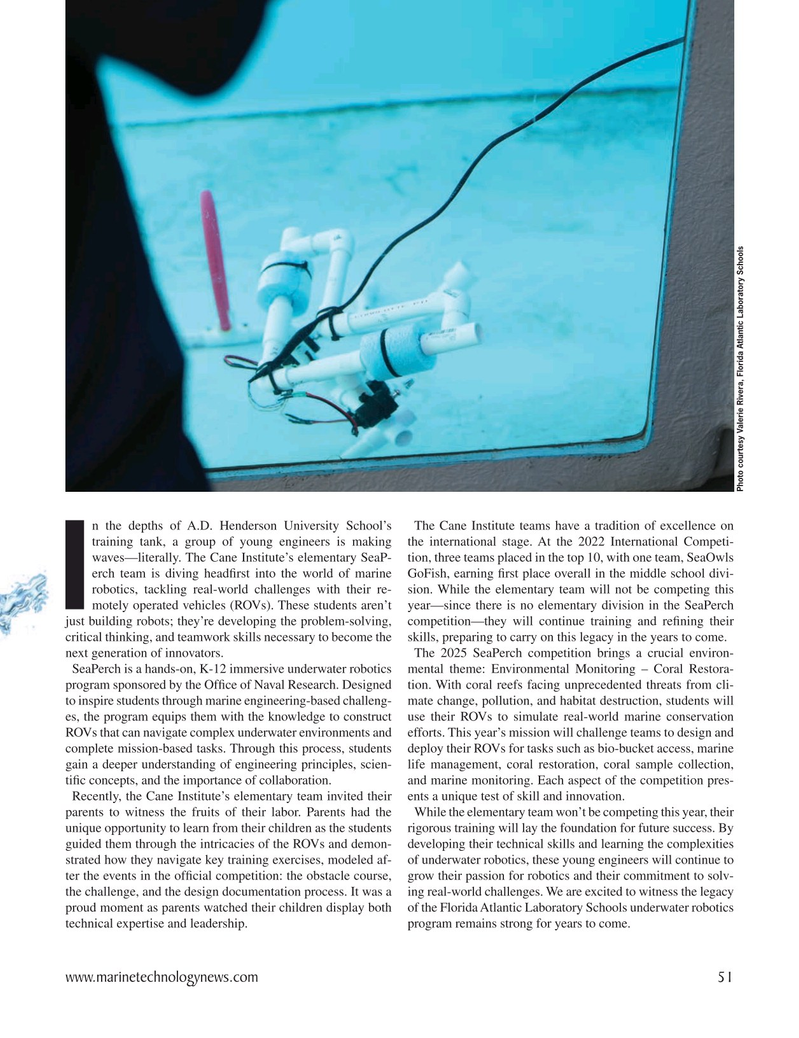
Page 51: of Marine Technology Magazine (March 2025)
Read this page in Pdf, Flash or Html5 edition of March 2025 Marine Technology Magazine
Photo courtesy Valerie Rivera, Florida Atlantic Laboratory Schools n the depths of A.D. Henderson University School’s The Cane Institute teams have a tradition of excellence on training tank, a group of young engineers is making the international stage. At the 2022 International Competi- waves—literally. The Cane Institute’s elementary SeaP- tion, three teams placed in the top 10, with one team, SeaOwls erch team is diving head? rst into the world of marine GoFish, earning ? rst place overall in the middle school divi- robotics, tackling real-world challenges with their re- sion. While the elementary team will not be competing this
Imotely operated vehicles (ROVs). These students aren’t year—since there is no elementary division in the SeaPerch just building robots; they’re developing the problem-solving, competition—they will continue training and re? ning their critical thinking, and teamwork skills necessary to become the skills, preparing to carry on this legacy in the years to come.
next generation of innovators. The 2025 SeaPerch competition brings a crucial environ-
SeaPerch is a hands-on, K-12 immersive underwater robotics mental theme: Environmental Monitoring – Coral Restora- program sponsored by the Of? ce of Naval Research. Designed tion. With coral reefs facing unprecedented threats from cli- to inspire students through marine engineering-based challeng- mate change, pollution, and habitat destruction, students will es, the program equips them with the knowledge to construct use their ROVs to simulate real-world marine conservation
ROVs that can navigate complex underwater environments and efforts. This year’s mission will challenge teams to design and complete mission-based tasks. Through this process, students deploy their ROVs for tasks such as bio-bucket access, marine gain a deeper understanding of engineering principles, scien- life management, coral restoration, coral sample collection, ti? c concepts, and the importance of collaboration. and marine monitoring. Each aspect of the competition pres-
Recently, the Cane Institute’s elementary team invited their ents a unique test of skill and innovation.
parents to witness the fruits of their labor. Parents had the While the elementary team won’t be competing this year, their unique opportunity to learn from their children as the students rigorous training will lay the foundation for future success. By guided them through the intricacies of the ROVs and demon- developing their technical skills and learning the complexities strated how they navigate key training exercises, modeled af- of underwater robotics, these young engineers will continue to ter the events in the of? cial competition: the obstacle course, grow their passion for robotics and their commitment to solv- the challenge, and the design documentation process. It was a ing real-world challenges. We are excited to witness the legacy proud moment as parents watched their children display both of the Florida Atlantic Laboratory Schools underwater robotics technical expertise and leadership. program remains strong for years to come.
www.marinetechnologynews.com 51
MTR #3 (50-63).indd 51 3/13/2025 1:03:33 PM

 50
50

 52
52
